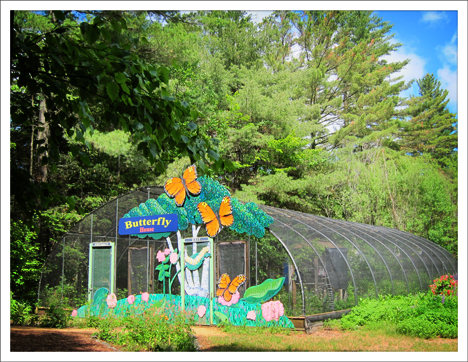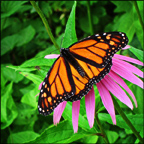Monarchs in the Meadow
Saturday, 25 August 2012
10:00 AM - 4:00 PM, rain or shine
Free -- Donations accepted.
 The Monarch Butterflies in the Paul Smiths VIC will be released on 25 August.
The Monarch Butterflies in the Paul Smiths VIC will be released on 25 August.
| 10 AM - 4 PM | Information on Monarchs, migration and tagging by butterfly expert Sue Grimm Hanley |
| 1 PM | Explore Drumming workshop with Inisheer's Erik Van Yserloo |
| 2 PM | Bird-on-Hand Demonstration with Mark Manske |
 The Monarch Butterflies in the VIC Native Species Butterfly House will be released on 25 August to begin their long journey south. The VIC is marking the event with a family-friendly celebration
of arts, music, and dance. The activities will take place in the Paul Smiths College VIC Butterfly House and adjacent meadow. This is a rain or shine event. The rain location is inside the VIC building, in the Great Room, on the rug. This is a great opportunity for families, nature lovers, folks who like to play music outdoors, and nature photographers. Call the VIC at (518) 327-6241 for more information.
The Monarch Butterflies in the VIC Native Species Butterfly House will be released on 25 August to begin their long journey south. The VIC is marking the event with a family-friendly celebration
of arts, music, and dance. The activities will take place in the Paul Smiths College VIC Butterfly House and adjacent meadow. This is a rain or shine event. The rain location is inside the VIC building, in the Great Room, on the rug. This is a great opportunity for families, nature lovers, folks who like to play music outdoors, and nature photographers. Call the VIC at (518) 327-6241 for more information.
 The Monarch Butterflies which will be released on 25 August have been living in the VIC Native-Species Butterfly House
during the summer. The Butterfly House features butterflies and moths in all stages of development. It is the only such facility in the Adirondacks and one of a very few in the northeast which concentrate on native species butterflies. The VIC butterfly house also hosts butterflies which migrate to the Adirondacks in the summer, including the Monarch Butterfly -- one of the most popular of the butterflies and moths in the Butterfly House.
The Monarch Butterflies which will be released on 25 August have been living in the VIC Native-Species Butterfly House
during the summer. The Butterfly House features butterflies and moths in all stages of development. It is the only such facility in the Adirondacks and one of a very few in the northeast which concentrate on native species butterflies. The VIC butterfly house also hosts butterflies which migrate to the Adirondacks in the summer, including the Monarch Butterfly -- one of the most popular of the butterflies and moths in the Butterfly House.
 Monarchs arrive in the Adirondacks in late May. These butterflies are the adults of the first generation which have emerged in late April in northern Mexico and the southern US. Some butterflies fly all the way north; others fly part way, with their children completing the journey. Here in the north the next generation of Monarchs emerges. In August or September, they begin a lengthy journey south to their wintering habitat in central Mexico -- 2,500 miles from the Adirondack Mountains. They soar and glide on wind currents much of the time and travel in very large groups. It is estimated that they fly up to fifty miles a day, arriving in Mexico in early November. Our Monarchs will be part of this miraculous migration.
Monarchs arrive in the Adirondacks in late May. These butterflies are the adults of the first generation which have emerged in late April in northern Mexico and the southern US. Some butterflies fly all the way north; others fly part way, with their children completing the journey. Here in the north the next generation of Monarchs emerges. In August or September, they begin a lengthy journey south to their wintering habitat in central Mexico -- 2,500 miles from the Adirondack Mountains. They soar and glide on wind currents much of the time and travel in very large groups. It is estimated that they fly up to fifty miles a day, arriving in Mexico in early November. Our Monarchs will be part of this miraculous migration.
References:
- The Miraculous Monarch Migration. Handout at the Paul Smith's College VIC Native Species Butterfly House.
- Monarch Watch.Org. http://www.monarchwatch.org/
- University of Minnesota Monarch Lab. http://www.monarchlab.org/Lab/
